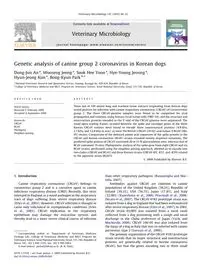
2010 Genetic analysis of canine group 2 coronavirus in Korean dogs PDF
Preview 2010 Genetic analysis of canine group 2 coronavirus in Korean dogs
Genetic analysis of canine group 2 coronavirus in Korean dogs Dong-Jun An a, Wooseog Jeong a, Sook Hee Yoon a, Hye-Young Jeoung a, Hyun-Jeong Kim a, Bong-Kyun Park b,* a National Veterinary Research and Quarantine Service, Anyang, Kyunggi-do, 430-824, Republic of Korea b College of Veterinary Medicine and BK21 Program for Veterinary Science, Seoul National University, Seoul, 151-742, Republic of Korea 1. Introduction Canine respiratory coronavirus (CRCoV) belongs to coronavirus group 2 and is a causative agent in canine infectious respiratory disease (CIRD). Recently, this virus emerged in England as a novel pathogen in the respiratory tract of dogs suffering from severe respiratory disease (Erles et al., 2003). However, CRCoV infection is thought to cause only subclinical or asymptomatic conditions (Erles et al., 2003). CRCoV replication in the respiratory epithelium may damage the mucociliar system, and thereby lead to a more severe clinical course of infection than other respiratory pathogens (Buonavoglia and Mar- tella, 2007). Antibodies against CRCoV are common in canine populations of the United Kingdom (36.2%), Republic of Ireland (30.3%), USA (54.7%), Japan (17.8%), and Italy (32.06%) (Kaneshima et al., 2006; Priestnall et al., 2006; Decaro et al., 2007). The CRCoV 4182 prototype strain was isolated from a dog in England that had been euthanatized after severe respiratory disease (Erles et al., 2007). In 2002, CRCoV strain 02/005 was isolated from a nasal swab collected from a dog presenting with a cough and nasal discharge in the Chiba prefecture of Japan (Yachi and Mochizuki, 2006). CRCoV 240-05 was also isolated from the lungs of a dog in Italy that was co-infected with canine parvovirus type 2 (Lorusso et al., 2009). The genomic organization of the CRCoV 4182 prototype strain reveals that its major structural and nonstructural proteins are genetically related to bovine coronavirus (BCoV), but that the genes encoding two or three small Veterinary Microbiology 141 (2010) 46–52 A R T I C L E I N F O Article history: Received 5 February 2009 Accepted 4 September 2009 Keywords: CRCoV BCoV Phylogeny Neighbor-joining A B S T R A C T Three out of 109 mixed lung and tracheal tissue extracts originating from Korean dogs tested positive for infection with canine respiratory coronavirus (CRCoV) of Coronaviridae group 2. The three CRCoV-positive samples were found to be competent for viral propagation and isolation, using human rectal tumor cells (HRT-18), and the structure and nonstructure proteins encoded in the 30-end of the CRCoV genome were sequenced. The small open reading frames situated between the spike and envelope genes of the three Korean CRCoV isolates were found to encode three nonstructural proteins (4.9 kDa, 2.7 kDa, and 12.8 kDa in size), as were the British (CRCoV G9142) and Italian (CRCoV 240- 05) strains. Comparison of the deduced amino acid sequences of the spike protein in the CRCoV and bovine coronavirus (BCoV) strains revealed twenty sequence variations. The predicted spike protein of CRCoV contained 20 or 21 N-glycosylation sites, whereas that of BCoV contained 19 sites. Phylogenetic analysis of the spike gene from eight CRCoV and six BCoV strains, performed using the neighbor-joining approach, allowed us to classify into two clades (CRCoV and BCoV) and three Korean strains (CRCoV-K9, -K37, and -K39) related to the Japanese strain 06/075. � 2009 Published by Elsevier B.V. * Corresponding author at: Department of Veterinary Medicine Virology Lab., College of Veterinary Medicine and BK21 Program for Veterinary Science, Seoul National University, Seoul, 151-742, Republic of Korea. Tel.: +82 2 880 1255; fax: +82 2 885 0263. E-mail address:
